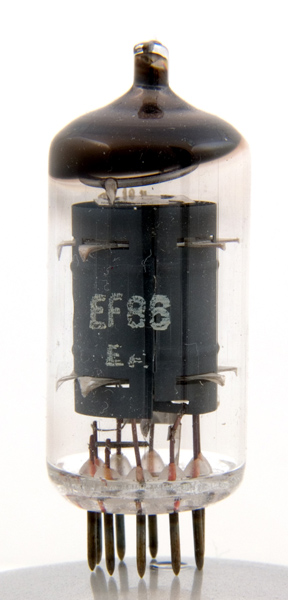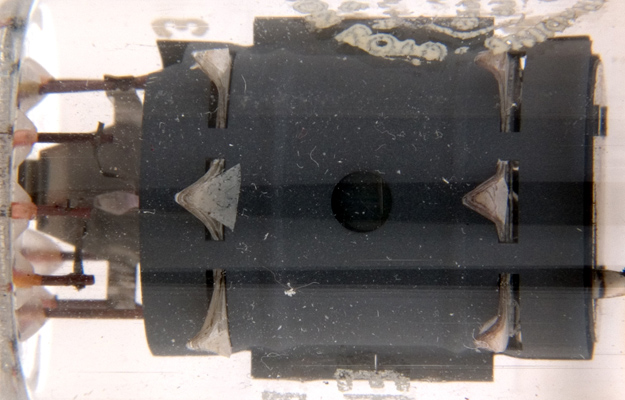|
EF86Sensibly equivalent¶ to:See also:
|
|
|

|
The EF86 is the standard early stage audio pre-amplifier valve. This exhibit is of unknown make but is unusual in that the outer screen is a cylindrical metal tube and not made of mesh.
The EF86 design is low noise and anti-microphonic. In use it is recommended that it is fitted into a vibration resistant base. This has a synthetic rubber mount.The landmark amplifier designs from Mullard's application laboratories all specified the EF86, and today it is still the valve of choice for this work. Before the advent of the EF86 the Mullard valve of choice for pre-amplifier stages was the EF37A Mullard, the designers of the EF86, describe it as a low noise pentode intended for use as a RC coupled AF voltage amplifier, particularly in the early stages of high gain audio amplifiers, microphone pre-amplifiers and magnetic tape recorders.Hum. When used as a normal voltage amplifier with a line voltage of 250 V and an anode load of 100 k Ohms and a grid resistor of 470 k the maximum hum level of the valve alone is 5 μV, the average value being about 3 μV when operated with one side of the heater earthed. This can be further reduced by centre tapping the heater to earth. Under these conditions the maximum hum level is 1.5 μV. The low level of hum attained with this valve can be completely masked by that due to an unsuitable valve-holder, in which excessive leakage and capacitive coupling between pins will introduce considerable hum.Noise. The low-frequency noise generated by a valve is most conveniently specified as an equivalent voltage on the control grid for a specific bandwidth. For the EF86 under normal conditions, I.e. line voltage of 250 V and an anode load of 100 k, the equivalent noise voltage is approximately 2 μV for the frequency range 25-10,000 Hz.Microphony. Care in the design of the valve to ensure that the electrode structure and its mounting are as rigid as possible has reduced the microphony of the EF86 to a very low level. There are no appreciable internal resonances at frequencies below 1 kHz. At higher frequencies the effect of vibration is usually negligible on account of the damping provided by the chassis and the valve holder. In high gain applications such as tape recording care should be taken in siting the valve, particularly when a loudspeaker is present in the same cabinet or where a motor is mounted on the same chassis. In such cases a flexible mounting for the valve-holder or a separated weighted sub-chassis is advisable.The thin glass tube envelope is 21 mm in diameter and excluding the B9A base pins, is 49 mm tall.References: Data-sheet & 1040. Type EF86 was first introduced in 1953. See also 1953 adverts. |
Pin Connections
| 1 | 2 | 3 | 4 | 5 | 6 | 7 | 8 | 9 |  g2 | s | k | h | h | a | s | g3 | g1 |
|
|
Absolute Maximum Operating Conditions¶
| Vh | Ah | Va | Vg | mAa | ra | gm | 
| 6.3 | 0.2 | 250 | -5 | 4 | 2.5M | 2 |
|
PDF scanned from an original document held by the museum |
Updated June 16, 2013.
|
|